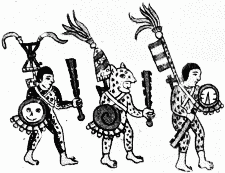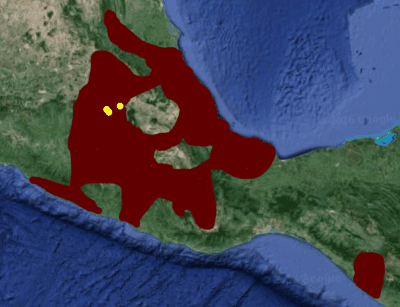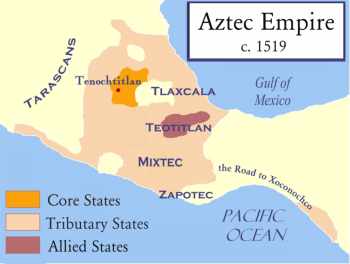
 |
Dig into the mysteries of Aztec history right here! What was ancient Aztec art and culture like? What about the Aztec religion? And the legendary Aztec sacrifices?
The Aztec Empire was peopled by a group that was once nomadic, the Mexicas. Their chroniclers told them that after their long journey from Aztlán, they found themselves to be outcasts, until they found the sign sent to them by their god Huitzilopochtli, and began to build their city. And so the Mexica peoples continued, and the Aztec Empire began.
The city of Tenochitlan was soon to become one of the largest cities in the world. The power of the Mexica peoples became more consolidated, and they began to form alliances. Their military power grew as well, and they began to conquer peoples in the surrounding areas.
At the height of its power, the Aztec Empire was organized and strong, but ruled with fear. In 1519, a clash of cultures was to take place, unlike anything before it. Although there was much tragedy in both the Spanish and Aztec empires before this, the meeting of the two civilizations was disastrous. In a few short years, the culture and structure of one of histories greatest empires would have virtually vanished.

Did you know...


This Aztec timeline includes the generally agreed upon dates of major events in the empire. For various reasons, experts dispute some dates, but this will give you an idea of the flow of events in the history of the empire, up until its fall.
| 6th century | First Nahuatl speaking peoples begin to settle in Mexico |
| 1110 | The Mexica travel from their northern homeland of Aztlan. These early dates, and the existence and location of Aztlan are hotly debated. |
| 1110-1248 | The Mexica roam the area which is now Mexico, trying to find a location in which to settle |
| 1248 | Mexica settle near Lake Texcoco, in Chapultepec, though they are soon expelled by the Tepanecs |
| 1299 | Mexica settle in Tizapan, by permission of the Culhuacan ruler Cocoxtli. |
| 1325 | Tenochtitlán is settled by the Mexica |
Building an Empire
| 1350 | Building of causeways with canals |
| 1370 | Death of Tenoch, religious ruler of the Mexica |
| 1376-1395 | The first king* of Tenochtitlán, Acamapichitli, rules |
| 1390 | Original construction of Templo Mayor beings in Tenochtitlán |
| 1395-1417 | The second king of Tenochtitlán, Huitzilihuitzli, rules. An alliance with the Tepaneca is created. |
| 1417-1427 | The third king, Chimalpopoca, has his relatively short reign. He is assasinated by the Tepaneca. |
| 1427-1430 | War with the Tepaneca. Up to this point the Tepaneca had been dominant in central Mexico, ruling from Azcapotzalco and taking tribute from the Mexica. |
| 1430 | Azcapotzalco conquered |
| 1431 | Establishment of the Triple Alliance between the Mexica, the Acolhua in the city Texcoco and the Tepaneca of Tlacopan. These cities became the foundation of the empire. |
| 1427-1440 | Tenochtitlán's fourth king, Itzcoatl, reigns |
| 1452 | Tenochtitlán severely damaged by flooding |
| 1452-1454 | Famine in Tenochtitlán |
Height of the Empire
| 1440-1469 | Reign of the fifth king, Moctezuma I, who is also referred to as Montezuma I |
| 1469-1481 | Tenochtitlán's sixth king, Azayactl, reigns |
| 1481-1486 | Reign of Tizoc, the seventh king of Tenochtitlán |
| 1486-1502 | Rule of Ahuitzotl, eighth king of the city |
| 1487 | Dedication of Great Temple (Templo Mayor) at Tenochtitlán. This was the 6th version of the temple. |
| 1492 | (Christopher Columbus's landing at Santa Domingo) |
| 1502-1520 | Reign of Moctezuma II, or Montezuma II, most famous of the Aztec kings and ninth king of Tenochtitlán |
| 1510 | Severe floods in Tenochtitlán |
Most people today are somewhat familiar with the Aztec empire. But it may surprise you to know that there is a great deal of disagreement over what kind of an "empire" it really was. This Aztec empire history may surprise you.
Of course, even the term Aztec is a bit misleading. It's a name that is used for a group of peoples in Central Mexico, but really there wasn't any one people group that was "Aztec". The Mexica people were at the heart of the empire, but there were many other cultures that formed the civilization that the Spanish were to discover.

Estimated area of Aztec power
If we use the term empire, we need to know what we mean by it. There were many empires throughout history, and they ruled people in very different ways. It might be helpful to go back and see exactly how the civilization started...
Aztec empire history
Many years after the Mexica people first built their proud city, Tenochtitlan (later to become Mexico City), they formed an alliance with two other cities - Texcoco (Tetzcoco) and Tlacopan (these three cities are shown as yellow dots in the map above). This Triple Alliance was to rule the Valley of Mexico until the Spanish arrived. However, over time one city become the most powerful - Tenochtitlan. It would become the heart of the Aztec civilization.
Essentially, the history of the empire is a history of city-states. As the empire expanded (which it began to do in earnest around 1428) it conquered more cities. Some cities resisted. Others were conquered and began to pay tribute.
How the empire was ruled
The city of Tenochtitlan was the military power, which spearheaded the conquest of new territory. But the Aztec emperor didn't rule every city state directly. Local governments would remain in place, but would be forced to pay varying amounts of tribute to the Triple Alliance (with most of the tribute going to Tenochtitlan).
For this reason scholar Alexander J. Motyl would call this empire a informal or hegemonic empire.
You also need to remember that the Aztecs didn't necessarily rule connected territories. Because they were conquering cities, they sometimes had power in "pockets" over an area.
But don't think that this was a weak empire. Ruling through a local government ensured that the locals would keep the people happy, and that there would be stability and continuity. This system worked very well for the peoples of the empire.
At its height
The empire might have continued to grow had not the Europeans arrived in 1519. At this time it was at its height, reaching from the Pacific to the Gulf of Mexico, from Central Mexico all the way to Guatemala, El Salvador and Honduras. See this map of the Aztec empire for a visual idea. Here's another conception:


This 12-foot-wide calendar stone helped the Aztec keep track of the year.
Photograph by Sébastien Lecocq / Alamy

To see all four pages of this lesson, click https://drive.google.com/drive/u/0/folders/0AFf-F5S2E_xcUk9PVA